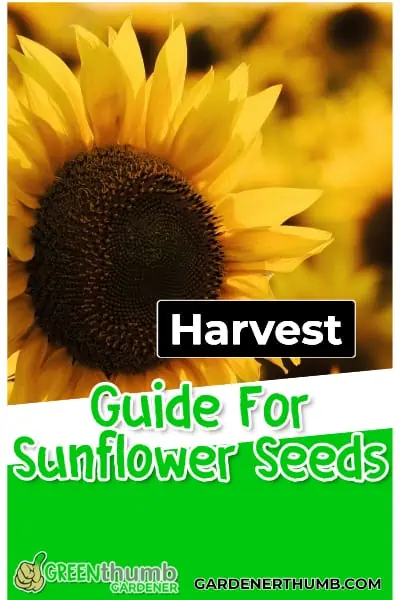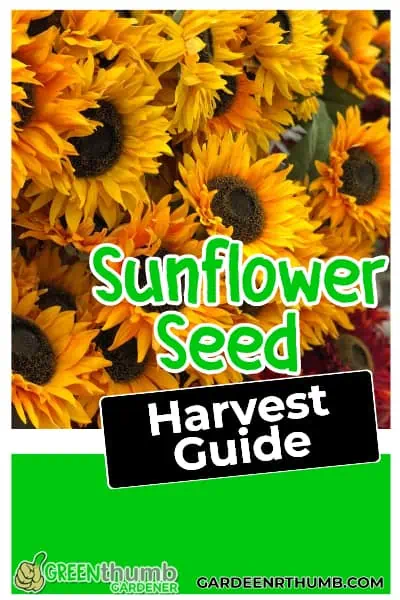How to Harvest Sunflower Seeds [Beginner’s Guide]
Sunflowers (Helianthus annuus), are an absolute must-have in your summer garden. Gardeners love them because they’re easy to grow and generate colorful seed heads. In addition, their golden yellow flower petals are a sight to behold in full bloom.
These annual flowers are available in over 70 distinct types; each other sunflower variety has its unique form, size, and color palette. Different flower varieties in a large variety of hues and textures can make your landscape and cut flower bouquets look amazing.
Their massive seed heads are harvested and dried for a variety of uses by many home gardeners.
You can keep some raw seeds in an envelope for replanting, eat roasted seeds for a nutritious snack, or added to your bird feeder.
Are you ready to learn how to harvest sunflower seeds?
Green thumb Gardener occasionally links to product and/or services offered by vendors to assist you with all your gardening needs. Some of these may be affiliate links, meaning we earn a small commission if items are purchased.
Want to Download a Garden Hack Guide for FREE

Enter your email below and we will send you a guide to help you SAVE money in your garden.
When To Harvest Sunflower Seeds
Native to the United States, sunflowers come in a range of colors and patterns. Most sunflowers are ready to be harvest 120 days after sowing.
However, this is subject to both climatic and genetic variations.
Harvesting typically begins in mid-September and lasts throughout October, but certain varieties can be picked as late as November. However, observing the sunflowers themselves is the most reliable method for determining harvest time.
You can look at the following signs:
- Flower heads start to droop and tilt downward
- The color of the leaf will change to yellow
- The petals wilting will dry and begin to fall off, exposing tightly-packed mature seeds.
- The back of the flower head will change color and turn to brown or yellow.
- Sunflower seeds will have a round form, and they can either be wholly black or have alternating black and white stripes.

As soon as you observe that the petals wilting and are beginning to drop, you can cover the seed head of the flowers with fine netting, brown paper bags, or perforated plastic bags to protect them from animals or eager birds that can nibble at the exposed seeds.
Steps For Harvesting Sunflower Seeds
Before harvesting the raw sunflower head seeds, it is necessary to plan how they will be dried, as this is a significant step in the process.
Harvesting can be done in one of two ways, depending on the drying method you want your seeds to have.
Harvesting When They Are Dried Out On The Stem
Some gardeners find it more convenient to let them dry out entirely on the stem before harvesting them once the backs have become brown. After that, you can chop the stem about an inch below where the heads were located.
You can follow these steps:
- Protect your ripe seeds from insects and birds by placing a paper bag or perforated plastic bag on the drying flower heads.
- Using a sharp pruning knife, cut the stem 1 inch below the head when the seeds are fully matured.
- Collect the seeds from the head by rubbing them between your fingers.
- Rinse the seeds after harvest by running cool water over them.
- Before storing the seeds, put them on a paper towel or a piece of newspaper to let the seeds dry.
- Place the dried seeds in an air-tight container.
Harvesting Earlier And Dry Indoors
Some people find it better to cut the stems of their sunflowers earlier when the undersides of their petals are yellow and dry them entirely indoors.
If you choose this method, you can follow these steps:
- First, remove the head from your stock, leaving around 6 to 8 inches of stalk behind it. (This is done when the outer seeds have matured and the inner seeds are getting close to being mature.)
- Hang inverted in a room that is warm and has adequate ventilation.
- Use paper bags to cover the heads.
- Wait until the seeds have lost their moisture and dried out.
- Rub a few of the seeds on the top of your head with your fingertips. They’re ready to be stored away if they’re easy to remove.
- Thoroughly clean the seeds by running cool water over them. Let them to drain for ten to fifteen minutes.
- To dry the seeds, place them on a paper towel or newspaper before storing them. Then, place them in a closed container.

How To Save Sunflower Seeds
After harvesting, you can use the seeds immediately or store them for sowing again next year. You should thoroughly dry your seeds before storing them.
The quality of the seeds is determined mainly by how well they are stored. Therefore, saving them in the appropriate environment will assist them in maintaining their quality for a more extended period and will slow down the process of their deterioration.
Environments with lower relative humidity and temperatures have been found to be suitable for the improved preservation of sunflower seeds. These conditions make it possible for the seeds to maintain a low level of chemical activity, which is essential for their capacity to germinate and retain vitality.
Compared to the natural environment, studies have indicated that conditions with low temperatures are superior for preserving seeds.
This is because the rate of chemical reactions and subsequent respiration is slowed down by low temperatures, which is beneficial for protecting the seeds.
How To Dry Sunflower Seeds For Eating Or Storage
In most cases, it is better to pick sunflower flowers as soon as they appear ready than to wait until their seeds have dried out on the stalk. This minimizes the losses caused by animals devouring the flowers.
Proper drying also ensures that the seeds are at their freshest and most flavorful before being eaten or stored. Once dried and cleaned, sunflower seeds can be eaten raw or roasted and used in several recipes. They can also be used for replanting for the next season.
You can dry sunflower seeds by following these steps :
1. Place a few clean newspapers in the bottom of a cardboard box that is relatively shallow. Cover the newspapers with a layer of paper towels.
2. After rinsing the sunflower seeds, spread them out in a single layer on the paper towel in a loose manner, leaving sufficient space between individual seeds to ensure enough ventilation.
3. Allow the seeds to air-dry overnight at room temperature.
4. Take away and dispose of any debris, including dead plant material and other materials.
5. Go through the loose seeds and pick out the ones that are the fullest; these seeds have the greatest potential to develop into mature plants and flourish.
6. Place the sunflower seeds inside a paper envelope. Make sure to write its variety and date. Then, place the envelope in an air-tight plastic freezer safe container and store it in a cold, dry place.
Tip: The vegetable drawer in your refrigerator is a fantastic place to start. Your seeds will stay fresh in an air-tight plastic container for weeks.
Once dry, you can store sunflower seeds for 2-3 months in a sealed container or up to a year if kept in the freezer.
Final Thoughts
Sunflowers, with their majestic seed heads, are one of the most eye-catching types of flowers that you could grow in your garden. So if you want to get the most out of your garden, you should try growing sunflowers.
During the summer, planting and gathering sunflower seeds is an excellent way to support pollinators. It’s also a great snack and used for feeding birds if you want to make suet cakes.
Seeds can be harvested from the cultivation of edible varieties. The most nutritious seeds come from fresh sunflower heads and contain the highest concentrations of vitamins and minerals.
For example, you can put a cup of seeds on a large baking sheet and put them in an oven for 10-15 minutes roasting time at 400°F.
Related Questions
How do I save sunflower seeds for next year?
To save the seeds for future planting, keep them in an air-tight container in a cold, dry place.
Can you eat sunflower seeds straight from the plant?
Yes, you can eat the raw sunflower seeds as soon as you remove them from the plant. Sunflower seeds are a delicious and healthy snack.
However, most prefer roasted sunflower seeds seasoned with salt. If you like the unsalted seeds, you can just omit the salt.








